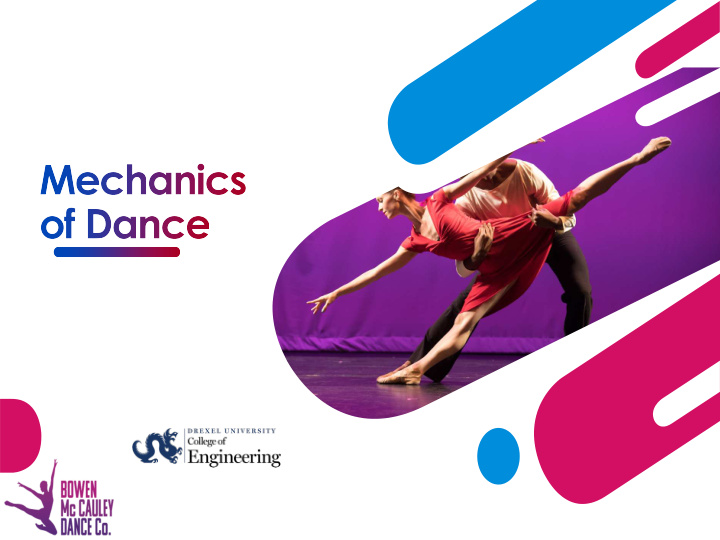



How do artists draw their inspiration? TRADITIONAL METHOD NOVEL APPROACH • Poetry • Draw inspiration from math, • Music science and engineering • Experiences • Feedback is more abstract and • Feedback usually instantaneous; quantifiable can see exactly what is happening in a mirror’s reflection 2
Who’s involved? THE TEAM THE GOALS • Bowen McCauley Dance Co. • Create a dance piece inspired by mathematical and • Last Name Left Productions engineering concepts • Drexel University 3
• Pi (π) is an irrational number and mathematical constant • Ratio of a circle’s circumference to its diameter • Pi is imperative to being able to quantify and define wave equations 4
• Pi (π) is an irrational number and mathematical constant • Ratio of a circle’s circumference to its diameter • Pi is imperative to being able to quantify and define wave equations 5
6
• Periodic motion or oscillation • Repetitive, forms some sort of pattern 7
• Also known as “Bowditch Curves” • Parametric equations that deconstruct into equations of simple harmonic motion • Lissajous figures relate to the frequency ratio of two waves and the phase lag between them 8
• ω is defined as frequency • ω 1 :ω 2 is the ratio between the frequencies of the two waves • f is defined as phase • Phase lag between waves means that they are not in sync 9
• Example of how two different waves can, when plotted together, form a new, unique pattern 10
11
12
• Initially discovered to visualize acoustic vibration phenomenon in the mid-nineteenth century • Used to analyze single tones, chords, and musical intervals of instruments 13
• Has not been investigated until this project • Accelerometers were used to measure acceleration in your x-, y- and z-directions 14
• Has not been investigated until this project • Accelerometers were used to measure acceleration in your x-, y- and z-directions Acceleration A vs. Time Acceleration B vs. Time 15
• Acceleration A vs. Acceleration B forms a Lissajous figure 16
• Eight dancers • Accelerometers were attached to various parts of the dancer’s body • Center of gravity • Ankle • Knee • Wrist 17
• Acceleration data from different dancers were recorded • Plotted individually • Plotted one dancer vs. another 18
19
Mackenzie, acceleration, right knee Aaron, acceleration, center of gravity 20
Resulting Lissajous Figure 21
Photo Credit: Jeff Malet 22
Performed May 17-18 th 2019 23
24
• Remind young boys and girls that science and the arts are not mutually exclusive • Continue this method in acceleration visualization analysis and apply it in other types of movements, like sports 25
• Lucy Bowen McCauley, Artistic Director & Helen M. Chamberlin, Executive Director, BMDC • Dr. Leslie Lamberson, Drexel University Dept. of Mechanical Engineering & Mechanics • Alexandria Will-Cole, PhD Candidate, Materials Science & Engineering Department • National Science Foundation Grant No. 1751989 • Additional Funding by: Dominion Energy, Community Foundation for Northern Virginia & Washington Forrest Foundation • BMDC Rehearsal Studio - Maryland Youth Ballet, Silver Spring, MD • Jordan Alexander Key, Ph.D. Music Composition – University of Florida • BMDC Company: Elenaluisa Alvarez, Aaron Bauer, Alicia Curtis, Patrick Green, Eve Holmes-Varner, Dustin Kimball, Justin Metcalf-Burton, & Mackenzie Rawls 26
Recommend
More recommend